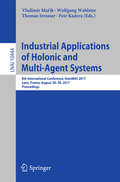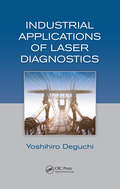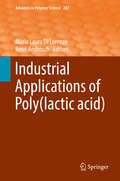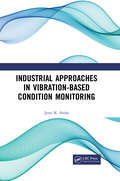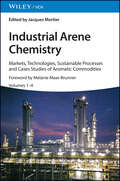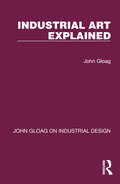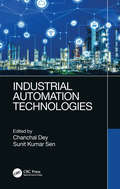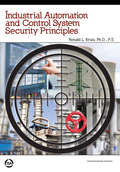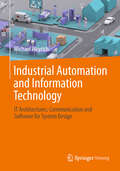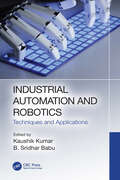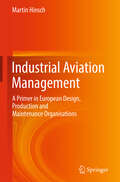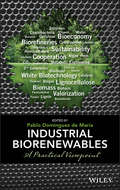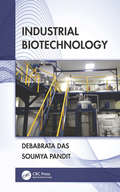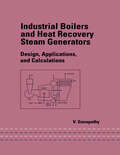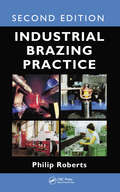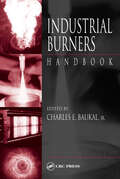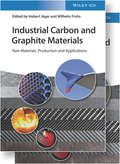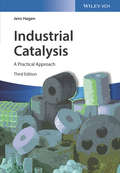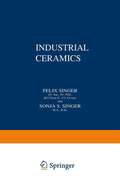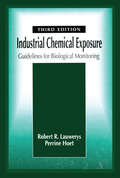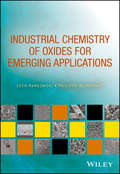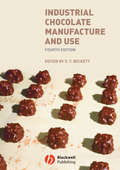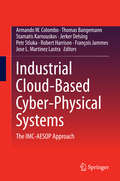- Table View
- List View
Industrial Applications of Holonic and Multi-Agent Systems
by Wolfgang Wahlster Vladimír Mařík Thomas Strasser Petr KaderaThis book constitutes the refereed proceedings of the 8th International Conference on Industrial Applications of Holonic and Multi-Agent Systems, HoloMAS 2017, held in Lyon, France, in August 2017. The 19 revised full papers presented were carefully reviewed and selected from 27 submissions. The papers are organized in the following topical sections: scheduling; knowledge engineering; modeling, simulation and reconfiguration; energy systems;and MAS in various areas.
Industrial Applications of Laser Diagnostics
by Yoshihiro DeguchiTighter regulations of harmful substances such as NOx, CO, heavy metals, particles, emissions from commercial plants and automobiles reflect a growing demand for lowering the anthropogenic burdens on the environment. It is equally important to monitor controlling factors to improve the operation of industrial machinery and plants. Among the many me
Industrial Applications of Poly (Advances In Polymer Science Ser. #282)
by Maria Laura Di Lorenzo René AndroschThe series Advances in Polymer Science presents critical reviews of the present and future trends in polymer and biopolymer science. It covers all areas of research in polymer and biopolymer science including chemistry, physical chemistry, physics, material science.The thematic volumes are addressed to scientists, whether at universities or in industry, who wish to keep abreast of the important advances in the covered topics.Advances in Polymer Science enjoys a longstanding tradition and good reputation in its community. Each volume is dedicated to a current topic, and each review critically surveys one aspect of that topic, to place it within the context of the volume. The volumes typically summarize the significant developments of the last 5 to 10 years and discuss them critically, presenting selected examples, explaining and illustrating the important principles, and bringing together many important references of primary literature. On that basis, future research directions in the area can be discussed. Advances in Polymer Science volumes thus are important references for every polymer scientist, as well as for other scientists interested in polymer science - as an introduction to a neighboring field, or as a compilation of detailed information for the specialist.Review articles for the individual volumes are invited by the volume editors. Single contributions can be specially commissioned.Readership: Polymer scientists, or scientists in related fields interested in polymer and biopolymer science, at universities or in industry, graduate students.
Industrial Approaches in Vibration-Based Condition Monitoring
by Jyoti Kumar SinhaVibration-based condition monitoring (VCM) is a well-accepted approach in industries for early detection of any defect, thereby triggering the maintenance process and ultimately reducing overheads and plant downtime. A number of vibration instruments, data analyzer and related hardware and software codes are developed to meet the industry requirements. This book aims to address issues faced by VCM professionals, such as frequency range estimation for vibration measurements, sensors, data collection and data analyzer including related parameters which are explained through step-by-step approaches. Each chapter is written in the tutorial style with experimental and/or industrial examples for clear understanding.
Industrial Arene Chemistry: Markets, Technologies, Sustainable Processes and Cases Studies of Aromatic Commodities, 4 Volume Set
by Jacques MortierIndustrial Arene Chemistry Explore the wide array of uses for aromatic hydrocarbons in this comprehensive reference Aromatics are a class of compounds—normally but not exclusively organic—which tend to be produced as by-products of various industrial processes. Their importance as petrochemical materials in themselves, along with the range of inter-relations between different aromatic chemicals, creates a complex and opportunity-filled market for aromatics. Industrial Arene Chemistry provides a thorough look at the conventional techniques required to use and produce these aromatic hydrocarbons. Beginning with an overview of the global aromatic market—including, but not limited to, manufacturers, markets of BTX, and downstream functional aromatics, aromatics derived from renewable sources, and economic forecasts—the book will also explore the impact shifting environmental factors will have on the future of aromatic chemistry. The text further explores BTX production processes differentiated according to the raw materials used. Importantly, this will establish the importance and growth of the biobased chemical industry. Industrial Arene Chemistry readers will also find: Case studies that describe major elements of specific technologies prototyped by contributors/companies as part of ongoing market development efforts Process chapters that include summaries of the conventional techniques and a more detailed discussion of recent high-impact studies Recent advances in conventional aromatic reactions, including alkylation, acylation and carboxylation, hydrogenation/reduction, oxidation, nitration/amination, sulfonation, and halogenation Industrial Arene Chemistry is a useful reference for chemists and chemical engineers who work with aromatics.
Industrial Art Explained (John Gloag On Industrial Design Ser.)
by John GloagOriginally published in 1934 this book became recognised as one of the principal standard works on industrial design and industrial architecture. The chapters explain the complete operation, character and background history of industrial art, its relation to architecture, materials, industrial production and retail distribution. It is fully illustrated with line drawings and photographs.
Industrial Automation Technologies
by Sunit Kumar Sen Chanchal DeyThe book begins with an overview of automation history and followed by chapters on PLC, DCS, and SCADA –describing how such technologies have become synonymous in process instrumentation and control. The book then introduces the niche of Fieldbuses in process industries. It then goes on to discuss wireless communication in the automation sector and its applications in the industrial arena. The book also discusses theall-pervading IoT and its industrial cousin,IIoT, which is finding increasing applications in process automation and control domain. The last chapter introduces OPC technology which has strongly emerged as a defacto standard for interoperable data exchange between multi-vendor software applications and bridges the divide between heterogeneous automation worlds in a very effective way. Key features: Presents an overall industrial automation scenario as it evolved over the years Discusses the already established PLC, DCS, and SCADA in a thorough and lucid manner and their recent advancements Provides an insight into today’s industrial automation field Reviews Fieldbus communication and WSNs in the context of industrial communication Explores IIoT in process automation and control fields Introduces OPC which has already carved out a niche among industrial communication technologies with its seamless connectivity in a heterogeneous automation world Dr. Chanchal Dey is Associate Professor in the Department of Applied Physics, Instrumentation Engineering Section, University of Calcutta. He is a reviewer of IEEE, Elsevier, Springer, Acta Press, Sage, and Taylor & Francis Publishers. He has more than 80 papers in international journals and conference publications. His research interests include intelligent process control using conventional, fuzzy, and neuro-fuzzy techniques. Dr. Sunit Kumar Sen is an ex-professor, Department of Applied Physics, Instrumentation Engineering Section, University of Calcutta. He was a coordinator of two projects sponsored by AICTE and UGC, Government of India. He has published around70 papers in international and national journals and conferences and has published three books – the last one was published by CRC Press in 2014. He is a reviewer of Measurement, Elsevier. His field of interest is new designs of ADCs and DACs.
Industrial Automation and Control System Security Principles
by Ronald L. KrutzThe use of cyber warfare as a prelude or substitute for conventional attacks has gone from conjecture to reality. The obvious targets of such assaults are a nation's defense establishment, critical infrastructure, and production capabilities. Contrary to popular opinion, there are effective, structured defenses against such aggression, if they are conscientiously and properly implemented and maintained. This text merges the fundamentals of information system security and the unique requirements of industrial automation and control systems and presents a clear and implementable formula to defend crucial elements, such as refineries, chemical plants, manufacturing operations, power plants and pipelines. This work develops a novel protection approach based on the merging of the best relevant and proven government and industry standards, resulting in a practical instrument that can be straightforwardly applied to secure our valuable resources. - See more at: https://www.isa.org/store/products/product-detail/?productId=116366#sthash.XjWjymcM.dpuf
Industrial Automation and Information Technology: IT Architectures, Communication and Software for System Design
by Michael WeyrichThe textbook provides knowledge of automation systems, their components and structures. Aspects of communication and real-time processing as well as the reliability and quality of software and hardware play an important role. Numerous application examples support the learning success.
Industrial Automation and Robotics: Techniques and Applications
by Kaushik Kumar Sridhar B. BabuThis book discusses the radical technological changes occurring due to Industry 4.0, with a focus on offering a better understanding of the Fourth Industrial Revolution. It also presents a detailed analysis of interdisciplinary knowledge, numerical modeling and simulation, and the application of cyber–physical systems, where information technology and physical devices create synergic systems leading to unprecedented efficiency. The book focuses on industrial applications of automation and robotics. It covers recent developments and trends occurring in both computer-aided manufacturing techniques, as well as computer-aided assembly techniques. Robots using embedded systems and artificial intelligence applications are also covered. Industrial Automation and Robotics: Techniques and Applications offers theoretical results, practical solutions, and guidelines that are valuable for both researchers and those working in the area of engineering.
Industrial Automation from Scratch: A hands-on guide to using sensors, actuators, PLCs, HMIs, and SCADA to automate industrial processes
by Olushola AkandeExplore industrial automation and control-related concepts like the wiring and programming of VFDs and PLCs, as well as smart factory (Industry 4.0) with this easy-to-follow guide Purchase of the print or Kindle book includes a free PDF eBookKey FeaturesLearn the ins and outs of industrial automation and control by taking a pragmatic approachGain practical insights into automating a manufacturing process using PLCsDiscover how to monitor and control an industrial process using HMIs and SCADABook DescriptionIndustrial automation has become a popular solution for various industries looking to reduce manual labor inputs and costs by automating processes. This book helps you discover the abilities necessary for excelling in this field. The book starts with the basics of industrial automation before progressing to the application of switches, sensors, actuators, and motors, and a direct on-line (DOL) starter and its components, such as circuit breakers, contactors, and overload relay. Next, you'll explore VFDs, their parameter settings, and how they can be wired and programmed for induction motor control. As you advance, you'll learn the wiring and programming of major industrial automation tools – PLCs, HMIs, and SCADA. You’ll also get to grips with process control and measurements (temperature, pressure, level, and flow), along with analog signal processing with hands-on experience in connecting a 4–20 mA transmitter to a PLC. The concluding chapters will help you grasp various industrial network protocols such as FOUNDATION Fieldbus, Modbus, PROFIBUS, PROFINET, and HART, as well as emerging trends in manufacturing (Industry 4.0) and its empowering technologies (such as IoT, AI, and robotics). By the end of this book, you’ll have gained a practical understanding of industrial automation concepts for machine automation and control.What you will learnGet to grips with the essentials of industrial automation and controlFind out how to use industry-based sensors and actuatorsKnow about the AC, DC, servo, and stepper motorsGet a solid understanding of VFDs, PLCs, HMIs, and SCADA and their applicationsExplore hands-on process control systems including analog signal processing with PLCsGet familiarized with industrial network and communication protocols, wired and wireless networks, and 5GExplore current trends in manufacturing such as smart factory, IoT, AI, and roboticsWho this book is forThis book is for both graduates and undergraduates of electrical, electronics, mechanical, mechatronics, chemical or computer engineering, engineers making a career switch, or anyone looking to pursue their career in the field of industrial automation. The book covers topics ranging from basic to advanced levels, and is a valuable reference for beginner-level electrical, IIoT, automation, process, instrumentation and control, production, and maintenance engineers working in manufacturing and oil and gas industries, among others.
Industrial Aviation Management: A Primer in European Design, Production and Maintenance Organisations
by Martin HinschThis book outlines the structure and activities of companies in the European aviation industry. The focus is on the design, production and maintenance of components, assemblies, engines and the aircraft itself. In contrast to other industries, the technical aviation industry is subject to many specifics, since its activities are highly regulated by the European Aviation Safety Agency (EASA), the National Aviation Authorities and by the aviation industry standard EN 9100. These regulations can influence the companies’ organization, personnel qualification, quality management systems, as well as the provision of products and services. This book gives the reader a deeper, up-to-date insight into today's quality and safety requirements for the modern aviation industry. Aviation-specific interfaces and procedures are looked at from both the aviation legislation standpoint as well as from a practical operational perspective.
Industrial Biorenewables: A Practical Viewpoint
by Pablo Domínguez de MaríaThis book provides a state-of-the-art perspective on industrial biorenewables. A selection of industries dealing with biomass as raw materials present their activities and industrial processes. Emphasis on each chapter includes, and is not limited to: discussion of the motivation of that specific industry to use biorenewables; a short history of their expertise and developments in the field; selected current R&D activities using biomass, the aim of the research, type of biomass used, catalysts, achieved products, economics, etc. ; detailed discussions of the type of biomass, indicating 1st or 2nd generation, and options to substitute 1st generation raw materials for more sustainable 2nd generation ones; current processes that have been or are about to be implemented at industrial and commercial scales; expectations such as where potential improvements could be made and where academic research groups could help provide pre-competitive and industrially-sound insights and research; and finally, conclusions, prospects, and recommendations for future directions of research.
Industrial Biotechnology
by Debabrata Das Soumya PanditIndustrial Biotechnology offers a comprehensive overview of biochemical processes, technologies, and practical applications of industrial biotechnology. The work comprises of chapters that discuss medium preparation, inoculum preparation using industrial strain and upstream processing, various fermentation processes, and physico-chemical separation processes for the purification of products and packaging. Analyzes problems within biochemical processes Discusses stoichiometry of bioprocesses Covers upstream and downstream processing Offers a wealth of case studies of different biochemical production processes, including those in development of food products, vaccines and medicines, single cell proteins, amino acids, cheese, biodiesel, biopesticides, and more This book is aimed at advanced students, industrial practitioners, and researchers in biotechnology, food engineering, chemical engineering, and environmental engineering.
Industrial Boilers and Heat Recovery Steam Generators: Design, Applications, and Calculations (Mechanical Engineering)
by V. GanapathyFilled with over 225 boiler/HRSG operation and design problems, this book covers steam generators and related systems used in process plants, refineries, chemical plants, electrical utilities, and other industrial settings. Emphasizing the thermal engineering aspects, the author provides information on the design and performance of steam generators
Industrial Brazing Practice
by Philip RobertsIn the past ten years, brazing technology has undergone sweeping changes. Yet because there are so few practitioners who understand the finer points of the technology, many of the companies that use brazing as their preferred metal-joining procedure are failing to use it to best effect. Fully updated to reflect the latest practices, this second edi
Industrial Burners Handbook (Industrial Combustion)
by Charles E. Baukal JrRapid development in the field precipitated by the increased demand for clean burner systems has made the Industrial Burners Handbook into the fields go-to resource. With this resource, bestselling author, editor, and combustion expert Charles Baukal, Jr. has put together a comprehensive reference dedicated to the design and applications of indust
Industrial Carbon and Graphite Materials: Raw Materials, Production and Applications
by JageerAn excellent overview of industrial carbon and graphite materials, especially their manufacture, use and applications in industry. Following a short introduction, the main part of this reference deals with industrial forms, their raw materials, properties and manifold applications. Featuring chapters on carbon and graphite materials in energy application, and as catalysts. It covers all important classes of carbon and graphite, from polygranular materials to fullerenes, and from activated carbon to carbon blacks and nanoforms of carbon.Indispensable for chemists and engineers working in such fields as steel, aluminum, electrochemistry, nanotechnology, catalyst, carbon fibres and lightweight composites.
Industrial Catalysis
by Jens HagenIn its 3rd edition, this comprehensive book offers all relevant information on catalytic processes in industry, including many recent examples. Perfectly suited for self-study, it is the ideal companion for scientists who want to get into the field or refresh existing knowledge.
Industrial Chemical Exposure: Guidelines for Biological Monitoring, Third Edition
by Robert R. Lauwerys Perrine HoetThe bestselling resource on industrial chemical assessment just got better. A practical guide to biological monitoring for industrial chemical exposure assessment, the THIRD EDITION of INDUSTRIAL CHEMICAL EXPOSURE: GUIDELINES FOR BIOLOGICAL MONITORING has been completely revised to include the latest developments in the field. In addition to an upd
Industrial Chemistry of Oxides for Emerging Applications
by Lech Pawlowski Philippe BlanchartValuable insights into the extraction, production, and properties of a large number of natural and synthetic oxides utilized in applications worldwide from ceramics, electronic components, and coatings This handbook describes each of the major oxides chronologically—starting from the processes of extraction of ores containing oxides, their purification and transformations into pure alloyed powders, and their appropriate characterization up to the processes of formation of 2D films by such methods as PVD, CVD, and coatings by thermal spraying or complicated 3D objects by sintering and rapid prototyping. The selection of oxides has been guided by the current context of industrial applications. An important point that is considered in the book concerns the strategic aspects of oxides. Some oxides (e.g. rare earth ones) become more expensive due to the growing demand for them, others, because of the strategic importance of countries producing raw materials and the countries that are using them. Industrial Chemistry of Oxides for Emerging Applications provides readers with everything they need to know in 7 chapters that cover: technical and economical importance of oxides in present and future; fundamentals of oxides manufacturing; extraction, properties, and applications of Al2O3; extraction, properties, and applications of ZrO2; synthesis, properties, and applications of YBaCu2O7x; extraction, properties, and applications of TiO2; and synthesis, properties, and application of hydroxyapatite. Presents the extraction, production, and properties of a large fraction of oxides applications worldwide, both natural as well as synthetic multi‐oxides Covers a very important segment of many industrial processes, such as refractories and piezoelectric oxides—both applications constituting very large market segments Developed from a lecture course given by the authors for over a decade Industrial Chemistry of Oxides for Emerging Applications is an excellent text for university professors and teachers, and graduate and postgraduate students with a solid background in physics and chemistry.
Industrial Chocolate Manufacture and Use
by Stephen T. BeckettSince the third edition of this standard work in 1999, there has been a significant increase in the amount of chocolate manufactured worldwide. The fourth edition of Industrial Chocolate Manufacture and Use provides up-to-date coverage of all major aspects of chocolate manufacture and use, from the growing of cocoa beans to the packaging and marketing of the end product. Retaining the important and well-received key features of the previous edition, the fourth edition also contains completely new chapters covering chocolate crumb, cold forming technologies, intellectual property, and nutrition. Furthermore, taking account of significant changes and trends within the chocolate industry, much new information is incorporated, particularly within such chapters as those covering the chemistry of flavour development, chocolate flow properties, chocolate packaging, and chocolate marketing. This fully revised and expanded new edition is an essential purchase for all those involved in the manufacture and use of chocolate.
Industrial Cloud-Based Cyber-Physical Systems
by Robert Harrison Stamatis Karnouskos Armando W. Colombo Thomas Bangemann Jerker Delsing Petr Stluka Francois Jammes Jose L. LastraThis book presents cutting-edge emerging technologies and approaches in the areas of service-oriented architectures, intelligent devices and cloud-based cyber-physical systems. It provides a clear view on their applicability to the management and automation of manufacturing and process industries. It offers a holistic view of future industrial cyber-physical systems and their industrial usage and also depicts technologies and architectures as well as a migration approach and engineering tools based on these. By providing a careful balance between the theory and the practical aspects, this book has been authored by several experts from academia and industry, thereby offering a valuable understanding of the vision, the domain, the processes and the results of the research. It has several illustrations and tables to clearly exemplify the concepts and results examined in the text and these are supported by four real-life case-studies. We are witnessing rapid advances in the industrial automation, mainly driven by business needs towards agility and supported by new disruptive advances both on the software and hardware side, as well as the cross-fertilization of concepts and the amalgamation of information and communication technology-driven approaches in traditional industrial automation and control systems. This book is intended for technology managers, application designers, solution developers, engineers working in industry, as well as researchers, undergraduate and graduate students of industrial automation, industrial informatics and production engineering.
